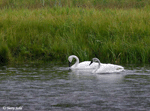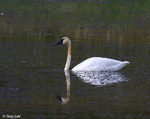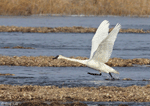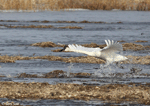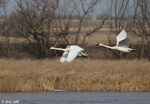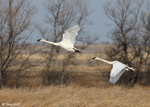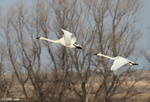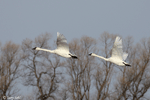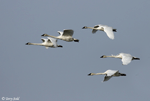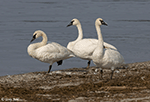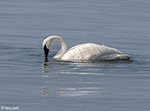Trumpeter Swan
Cygnus buccinator
| Length: 60 to 72 inches | Wingspan: 6 to 8.5 feet | Seasonality: All Seasons |
| ID Keys: Very large all-black bill, white plumage, large size. Compare to Tundra Swan. | ||
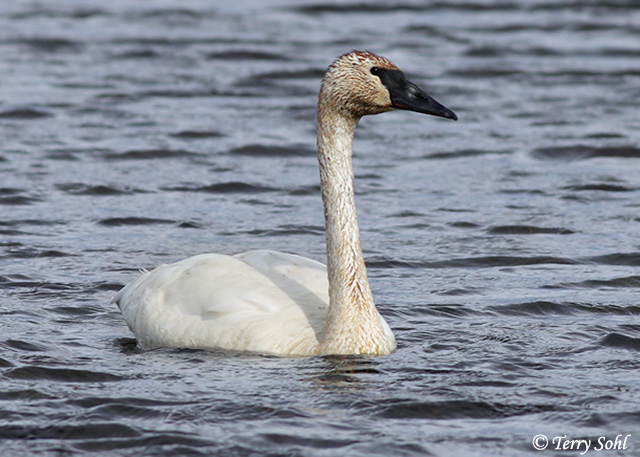 The Trumpeter Swan is the
heaviest of all native North American birds. They were hunted nearly to
extinction during the 19th and early 20th centuries, but have slowly recovered
since the 1940s. Their recovery has been assisted by local re-introduction
efforts, including in areas where birds haven't been seen in decades. They are often quite sensitive to human disturbance,
although in recent decades, local populations have become accustomed to a human
presence in parks and reservoirs.
The Trumpeter Swan is the
heaviest of all native North American birds. They were hunted nearly to
extinction during the 19th and early 20th centuries, but have slowly recovered
since the 1940s. Their recovery has been assisted by local re-introduction
efforts, including in areas where birds haven't been seen in decades. They are often quite sensitive to human disturbance,
although in recent decades, local populations have become accustomed to a human
presence in parks and reservoirs.
In South Dakota, Trumpeter Swans nest in select locations in western South Dakota. In winter, many are sometimes concentrated in and around LaCreek National Wildlife Refuge.
Habitat:
Favors large shallow water bodies with abundant vegetation, including shallow lakes, ponds, and large rivers. They will also use saltwater bays in the wintertime.
Diet:
Primarily feeds on aquatic plants. They may also feed on waste grain and terrestrial grasses, especially in the winter when other food sources aren't available. Only very young cygnets eat insects and crustaceans.
Behavior:
Forages by swimming, taking food items from the water's surface, water's edge, or by tipping and extending the head down to grab food from underwater. They will also forage on land.
Nesting:
April through July. The nest of a Trumpeter Swan is built on a protected spot surrounded by water, typically with relatively shallow water around the nest site. The most frequent nesting sites are old muskrat houses, beaver dams, small islands, or mounds of vegetation constructed by the birds themselves. The nests are often massive structures of up to 10 feet across, built of a mound of wetland vegetation in which the female forms a depression for the nesting site. Occasionally feathers or other material is used to sparsely line the inner bowl of the nest. The female lays between 4 and 10 eggs, and she alone incubates them. The young hatch after about 30-35 days. The youngsters leave the nest within a day of hatching and are fully capable of swimming and foraging for their own food, while the parents protect them from harm.
Trumpeter Swan pairs may mate for life, often forming a bond a year or two before they're even ready to begin breeding. The pair typically stays together in migration and on their wintering grounds as well, with the young of the year also often accompanying the parents that first winter. Trumpeter Swans are often faithful to a specific nest site and may return year after year, repairing damage from the previous year and adding new material if necessary.
Song:
Rich, resonating honking, typically of one or two notes.
- Click here to hear the honking of a small flock of Trumpeter Swans as they take flight1
- Click here to hear the honking of a lone Trumpeter Swan2
Migration:
Many populations in the lower 48 states are non-migratory. Those in Canada and Alaska, however, do move southward as waters begin to freeze.
South Dakota "Hotspot":
LaCreek National Wildlife Refuge is the place to look for Trumpeter Swans in South Dakota. They could be present at LaCreek at any time of year, given open water is available. Early spring is a great time to look for them, the birds seem to often concentrate there before some dispersal to scattered nesting sites in the lakes and wetlands of the nearby Sandhills and in southwestern South Dakota.
Interactive eBird Map:
Click here to access an interactive eBird map of Trumpeter Swan sightings
Similar Species:
There are two other swan species that could potentially be confused with a Trumpeter Swan, one that is native and is also sometimes found in South Dakota, and one that is introduced (with escapees or introduced birds occasionally seen in the state).
- Tundra Swan - Tundra Swans are migrants in South Dakota, most commonly seen in the northeast part of the state. They are very similar in overall appearance to a Trumpeter Swan and could easily be confused with one. They are a smaller bird, a difference that's obvious if the two species happened to be side-by-side, but often difficult to judge for a bird seen in isolation. Visually identification comes down to minor differences on the head. Tundra Swans (often) have a yellow spot right where the black bill meets the eye, while Trumpeter Swans do not. In a Tundra Swan, the bill coloring that meets the eye is minimal, while there seems to be more of an extensive "connection" between the bill and eye in a Trumpeter Swan. If a bird is seen head on or from above, the shape of where the bill meets the head is diagnostic, with more of a gradual "U" shape in the boundary between the black bill and white forehead on a Tundra Swan, and more of a "V" shape on a Trumpeter Swan.
- Mute Swan - Mute Swans are not native to North America, but they are often kept as ornamental birds, and over the years some have escaped. There are now freely breeding Mute Swans in scattered locations throughout North America, and one could show up almost anywhere. In terms of appearance, the obvious difference is the bill, as Mute Swans have an orange bill (black on a Trumpeter Swan) that often has a black "knob" near the face. Posture is also a clue, as Mute Swans often hold their neck/head in a rounded curve, while Trumpeter Swans are more erect.
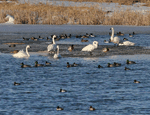 |
 |
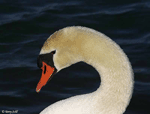 |
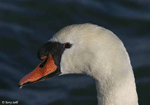 |
| Tundra Swan | Tundra Swan | Mute Swan | Mute Swan |
Conservation Status:
Trumpeter Swans once nested over much of North America, but were nearly wiped out in the Lower 48 by 1940. Numbers have rebounded locally in many locations, particularly in the Pacific Northwest, and efforts are underway to reintroduce the species into many parts of their historic range. They are now found across a very broad geographic area, and their range and numbers continue to expand. The IUCN currently considers the Trumpeter Swan to be a species of Least Concern.
Further Information:
Photo Information:
August 10th, 2010 - Potter's Marsh south of Anchorage, Alaska -- Terry Sohl
Additional Photos:
Click on the image chips or text links below for additional, higher-resolution Trumpeter Swan photos.
Audio File Credits:
- 1Tayler Brooks. Recorded in Grays Harbor, Washington on December 13th, 2009. Original recording and information available from xeno-canto.
- 2Andrew Spencer. Recorded in Lake of the Woods County, Minnesota on June 7th, 2012. Original recording and information available from xeno-canto.
| Click on the range map for a higher-resolution view |
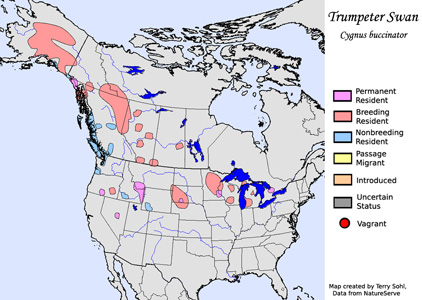 |
| South Dakota Status: Uncommon summer resident and common winter resident in Bennett County. Casual to rare elsewhere in the state. |
Additional Trumpeter Swan Photos
Click for a higher-resolution version of these photos
